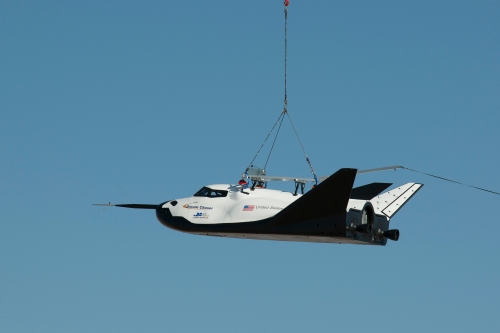SNC Conducts First Captive Carry Test at Dryden
From SNC Press release yesterday: Sparks, NV – August 22, 2013 – Today Sierra Nevada Corporation’s (SNC) Dream Chaser® spacecraft successfully completed a full-scale captive-carry test. The test in which the Dream Chaser was carried under an Erickson Air-Crane helicopter was conducted at NASA’s Dryden Flight Research Center in Edwards, Calif. The captive-carry test was performed in order to test and validate several of the Dream Chaser systems and sub-systems prior to the upcoming free-flight test. The software tested included: flight computer; guidance, navigation and control; aero surfaces; and the landing gear and nose skid, which was deployed during flight. In May 2012, SNC performed a similar, but less extensive, captive-carry test in Broomfield, Colo., under the Commercial Crew Development 2 (CCDev2) agreement with NASA’s Commercial Crew Program. “Today is the first time we have flown a fully functional Dream Chaser spacecraft, and we are very pleased with the results,” said Mark Sirangelo, corporate vice president and head of SNC’s Space Systems. “Our team represents the very best in collaboration between industry and government. We have worked closely with NASA, Dryden and the Air Force to reach this important milestone in our flight test program. We will continue to work together to prepare for the approach-and-landing free-flight test. We look forward to seeing Dream Chaser land on the same runway as the space shuttle orbiters once did as we move forward in the development of the next-generation crew transportation vehicle.” Note: A number of observers have pointed out that NASA really seems to want to see the Dream Chaser project come to fruition, and given the agency’s long history with the Shuttle it is an understandable sentiment backed by some sound reasoning regarding the benefits of winged re-entry. One thing to keep in mind however, is that NASA has also actively promoted the Commercial Crew program for its potential in serving other, non-NASA customers in low Earth orbit. At this point, aside from very speculative satellite servicing missions, that would appear to be pretty much limited to Bigelow Aerospace and its proposed BA-330 station. It is somewhat surprising then, that there has been little information released regarding any pricing agreement between the two companies for service to the Bigelow station, as there has been with both SpaceX and Boeing. There is another point of consideration concerning pricing, and the Atlas V launch vehicle.
Boeing, a 50/50 partner in United Launch Alliance, and perhaps reading the writing on the wall regarding the Atlas V and pricing which does not seem to be coming down, has recently re-iterated its willingness to look at the SpaceX Falcon 9 as an alternate booster for the CST-100 capsule following the first two test flights. Although it is perhaps not entirely out of the question, it seems much less likely that Sierra Nevada would follow a similar path, considering its partnership with Lockheed Martin in building and integrating the Dream Chaser.



“…backed by some sound reasoning regarding the benefits of winged re-entry”: I was not aware that there were any benefits to winged re-entry. AFTER re-entry, wings may well provide for a greater cross-range, but if you are unable to land where you intend, it is surely your de-orbit calculations and burn that are the problem and not wings or a lack thereof. If anyone knows of any “sound reasoning” to the contrary then I am quite willing to be educated.
Also, I had not been aware, and am rather surprised, that Boeing would seriously consider F9 over a Boeing Atlas V. It would certainly make for an interesting Boeing/ULA commercial for the Atlas V: “The Atlas V: So good we chose someone else’s rocket”.
If the CST-100 were to ride on a Falcon 9, how would Boeing and ULA continue to justify the existence in the market of the Atlas V ?.
ULA justified the Atlas V & the Delta IV launch vehicles just for NRO, military & other US government agencies customers as currently. Both of these launchers together have less than a dozen commercial missions in the pass & upcoming.